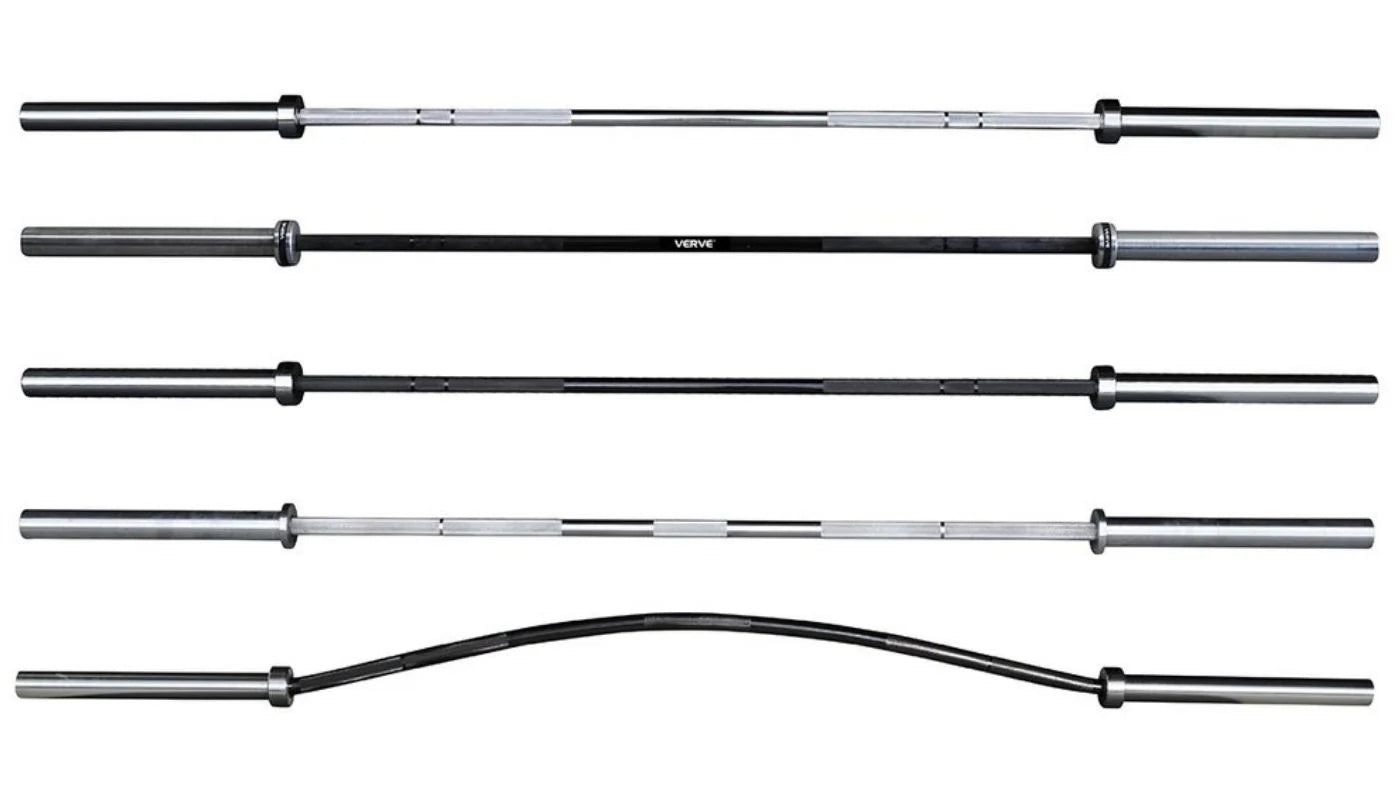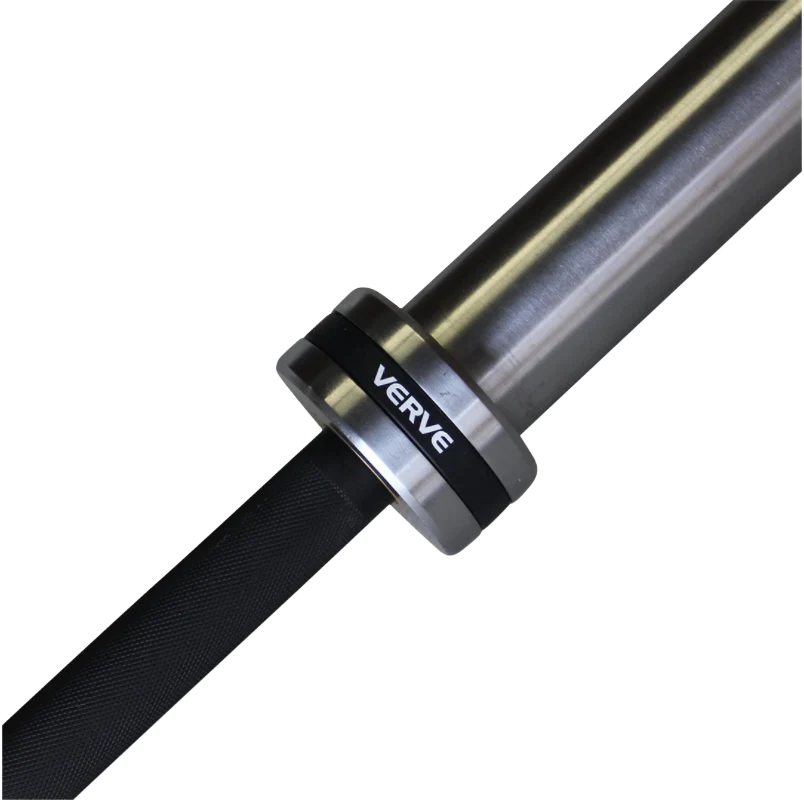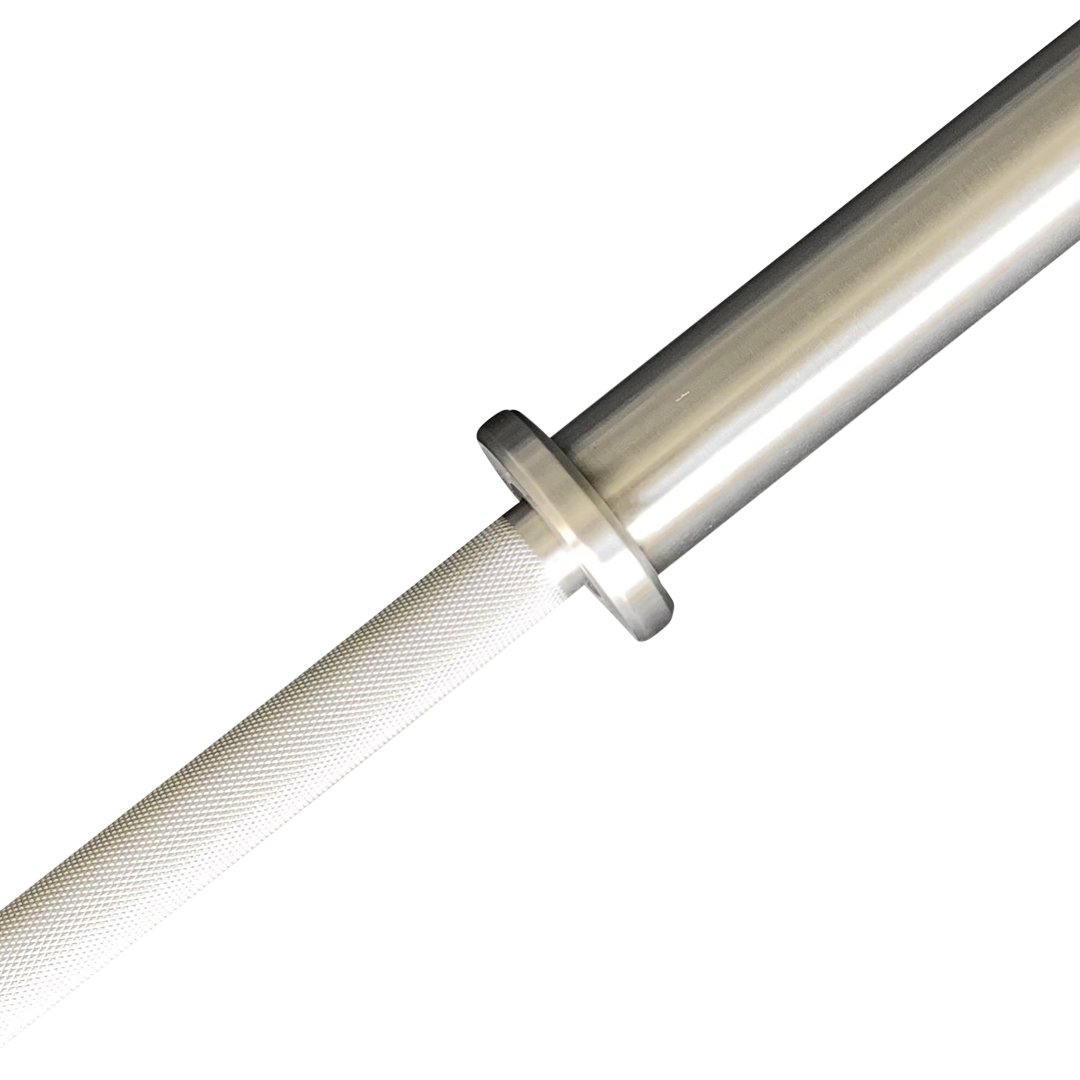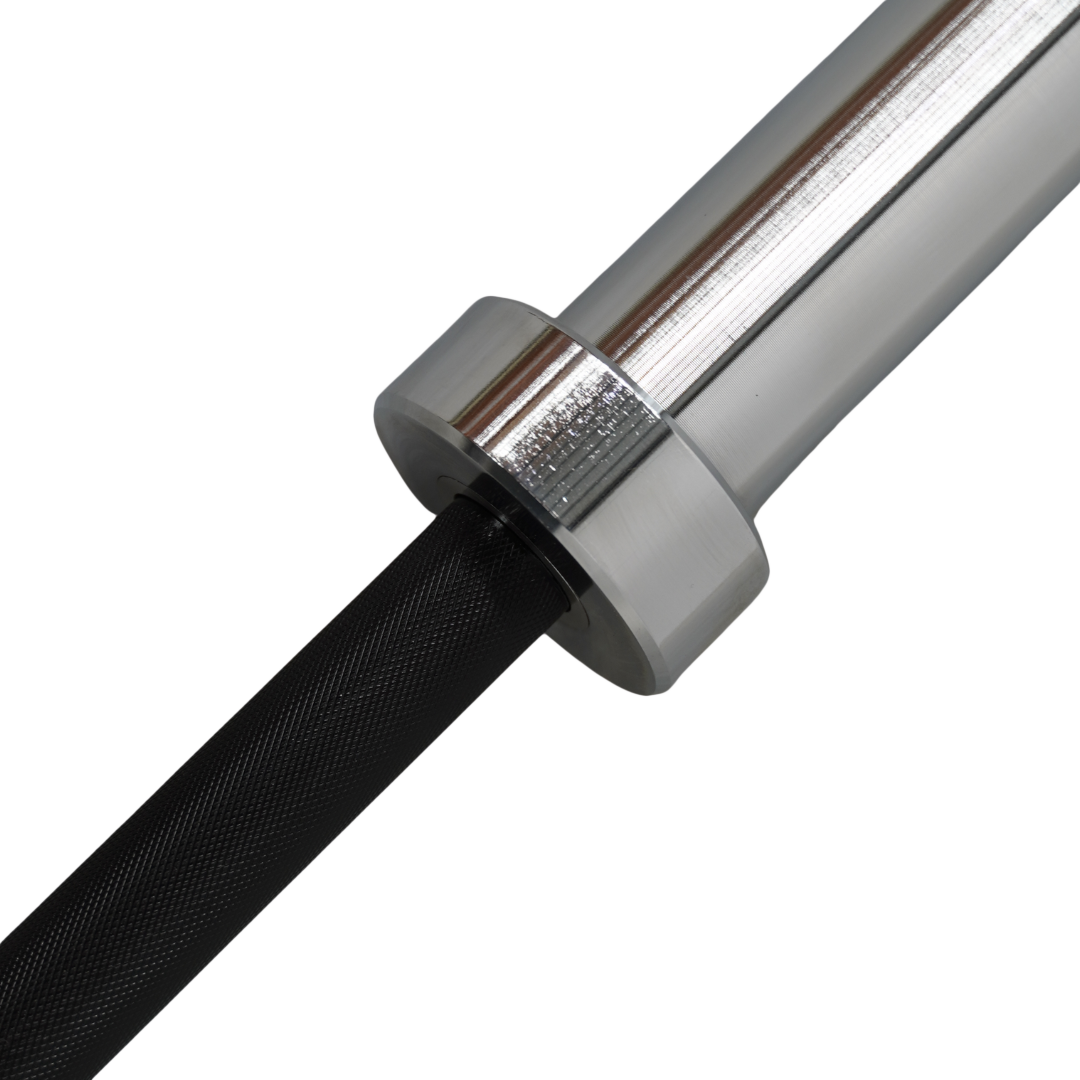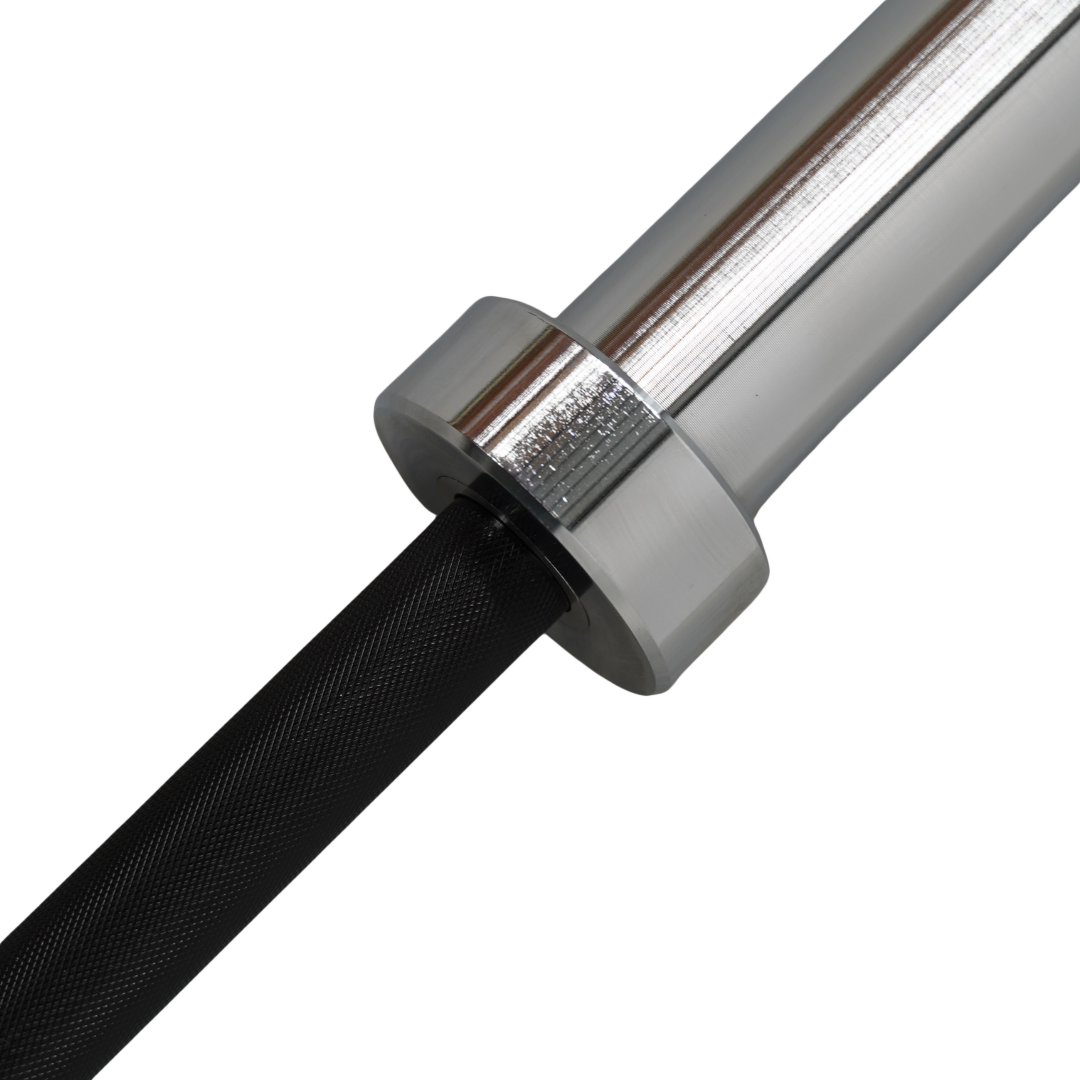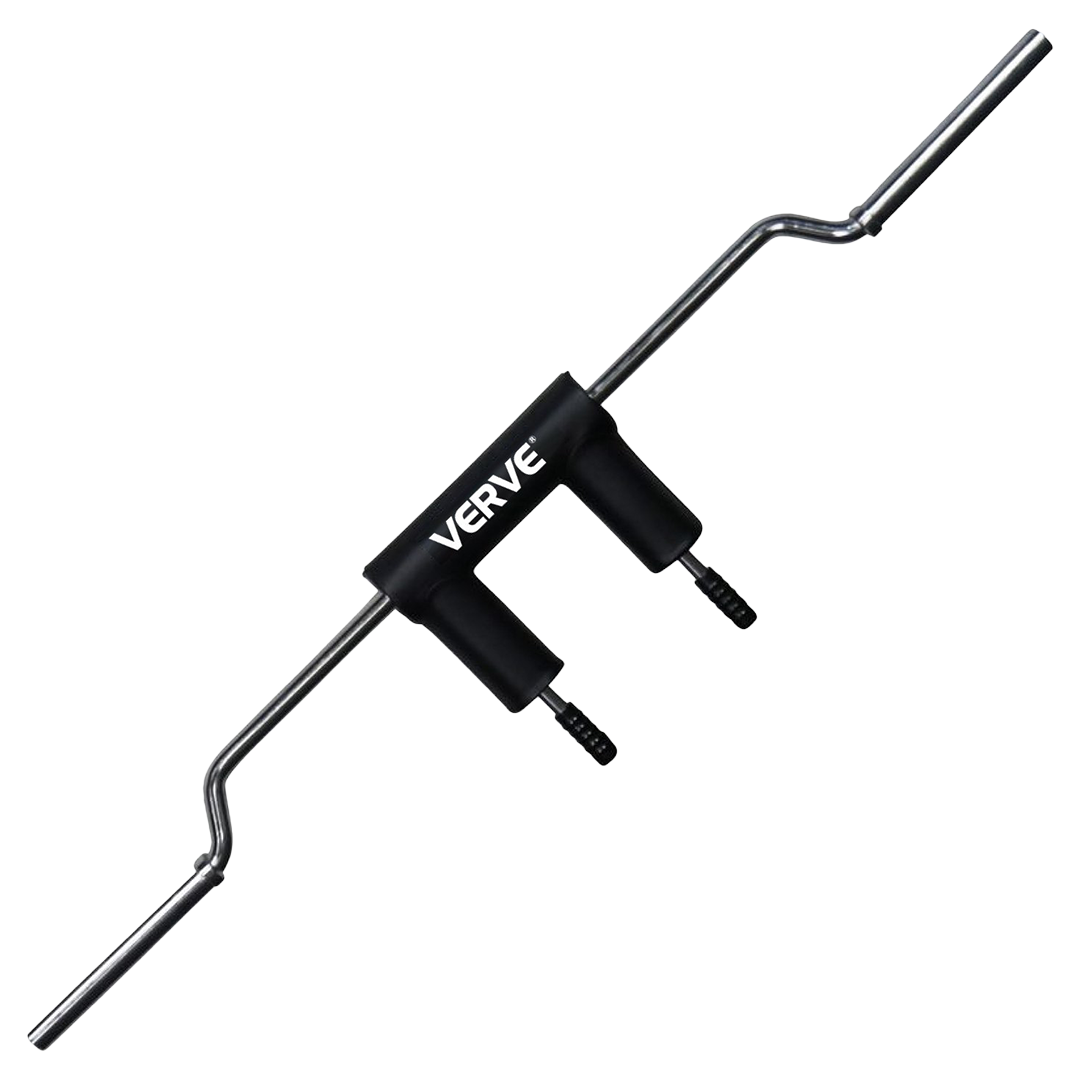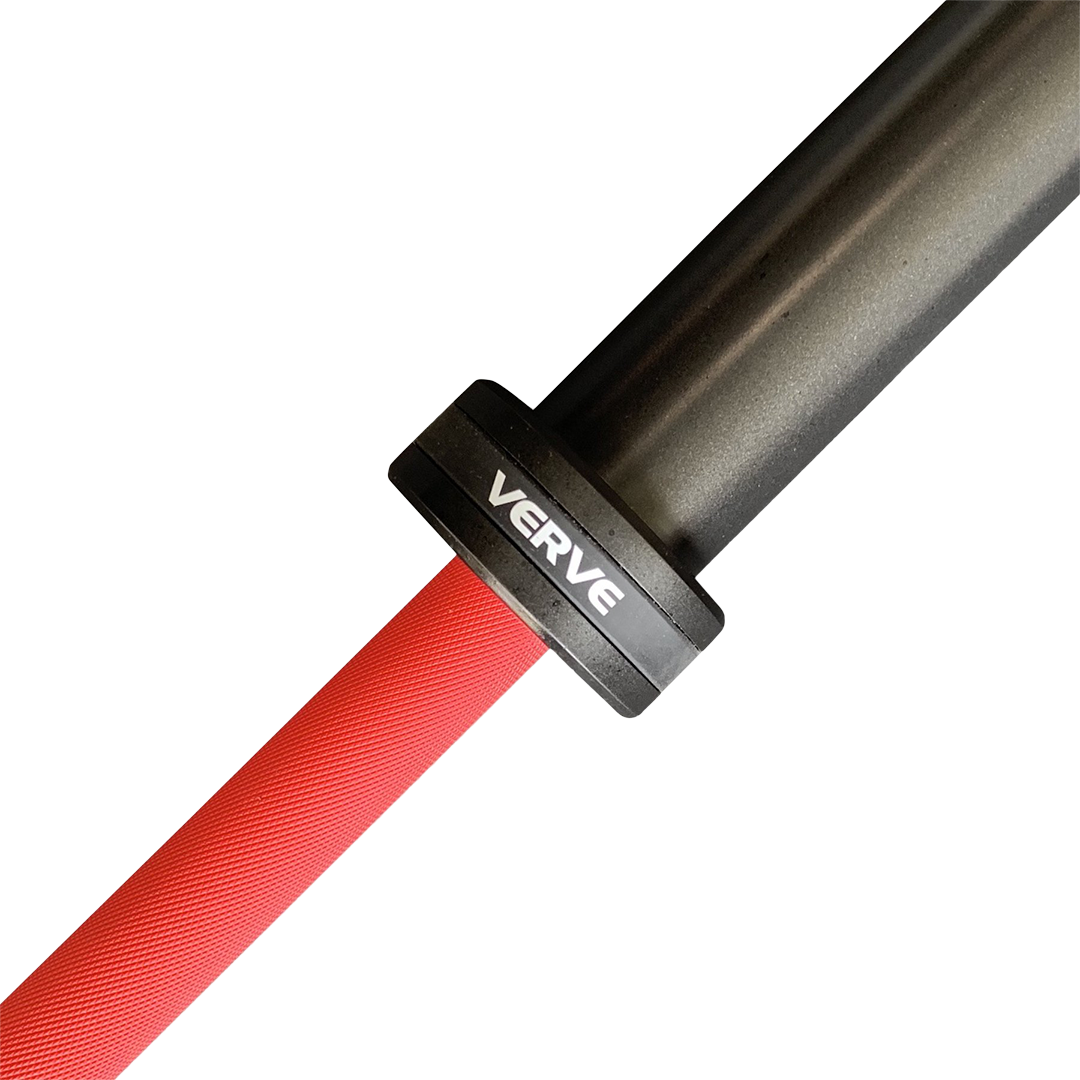If you are new to buying a barbell you can quickly find out that there is more to learn about them than you expected.
There can be strong lifters at the gym who just grab whatever bar is available at the time and eventually they notice one bar is their favourite. However, they may not quite sure of the technical differences and what it is about the bar that they like.
There is more to the design and construction of barbells than you might expect and it could even seem a little overwhelming. We aim to simplify it for you at the end. Sit back, grab a drink and you'll never look at a barbell in the same way again.
How did buying a barbell get so complicated?
Back in the day, bodybuilders and powerlifters were often the same people. “Get strong to get big” was the formula that stood for years. While it is still true, bodybuilding and powerlifting are separated, and we even have strongman competitions. And of course, there is Olympic weightlifting as an independent sport.
Disciplines branched out, and so did the equipment. Specific needs of top-level athletes complicated even the most basic pieces like barbells. That is easy to understand, considering that barbells are still most widely used, especially in the powerlifting and Olympic weightlifting world.
Even the smallest variations in bar flexibility, knurling, or thickness make a world of difference. Different bars will allow you to lift more weight, hit muscles from new angles, or completely new muscle groups. With some, you will exercise with more comfort, with others you will do it safely. We will explain each type in depth, in the section below.
Common Barbell Types
Standard and Olympic Barbells
The two most common barbell types are standard and Olympic. These look the same at first glance, but you will notice the difference as soon as you put one alongside another.

Standard barbell is shorter than the Olympic. An Olympic barbell is 7 feet long and weighs 45 lbs. Standard barbells are shorter, and are 5-6 feet, weighing 15-25 lbs.
These two bar types also use different weights. You can’t use standard plates on an Olympic barbell, as they are thicker, two inches in diameter. But, if you get a special sleeve, you can put Olympic plates on a standard bar. It is worth noting that standard plates and bars are much cheaper than Olympic.
Also, Olympic barbells can hold more weight, some going up to 1500 lbs. Standard bars max at about 200 lbs.
Olympic barbells have rotating bearings/bushings and sleeves, which reduces the amount of torque, relieving the joints. These barbells also slightly flex when under heavy tension (they have“whip”). When you think about barbell clean, or other Olympic lifts, you see why that’s important. Standard barbells have no whip and no rotating parts.
The knurling is also different, at least in most cases. Most Olympic barbells have no knurling in the middle, to prevent neck and upper chest irritations when catching the bar. Standard barbells, on the other hand, have more knurling allowing maximum grip, which is very important on back squats and deadlifts. However, knurling, whip, and other fine details vary, depending on the purpose and the type of bar you get, which we will discuss later.
Men’s, Women’s and Youth’s Barbells
Olympic bars are standardised and there are differences between men’s and women’s. Some manufacturers even make specific barbells intended for youths. Here is how it looks:
- Men’s barbell
- Weight: 20kg (45 lbs)
- Length: 2.2m (86.4 inches) long
- Diameter of shaft: normally 28mm, but can be 28.5mm or 29mm for powerlifting bars and even higher for axel bars

- Women’s barbell:
- Weight: 15kg (33 lbs)
- Length: 2.01m (79.2 inches)
- Diameter of shaft: 25mm

- Youth’s barbell (usually):
- Weight: 10kg (22 lbs)
- Length: 1.52m (60 inches) long
- Diameter of shaft: 25mm
Specific Barbell Features
Rotation, Bushings, Bearings
We have already explained why Olympic barbells need rotating parts—it’s the nature of the Olympic lifts, which produce a lot of force, and a lot of torque. To make the plate spinning possible, which dampens the torque, barbells have bushings and/or bearings.

These sit between the inner (static) and the outer (rotating) sleeve of the barbell. Without them, the rotation would create too much friction, wearing the barbell down, and preventing smooth rotation.
Bushings are simpler, they are just brass or bronze rings, that sit between the inner and outer sleeve, smoothing out the rotation.
As for bearings, there are three types of them - needle, ball, and thrust. The more bearings a barbell has, the better quality it is. Needle bearings are the best. Usually, barbells with needle bearings combine them with bushings, for optimal lifting experience.
Is there a difference? Bushings barbells are a better option for slower lifts, which means powerlifting and bodybuilding type of training. Bearings barbells are better for explosive lifts such as snatches and cleans as they have more spin.
Yield vs. Tensile vs. Test Strength
These terms explain how strong the barbell actually is, in absolute terms:
- Yield strength describes the “deformation” weight or the maximal amount of weight the bar can take before it permanently bends, staying like that after de-loading.
- Tensile strength is the maximal amount of weight the bar can hold without breaking.
- Test strength is the maximal amount of weight used when the manufacturer tested it.
As you can imagine, these numbers are all quite high, for most Olympic and especially powerlifting barbells.
Although you probably think you won’t go near that number, you still want your barbell to be as strong as possible. Even though you won’t approach its limits, any barbell lifts thousands of pounds across its lifetime. The more absolute durability it has, the less damage it will take on normal day-to-day activities.
Load Capacity
Barbell load capacity is determined by the length of the “sleeve” or the end of the baron which you stack plates. The longer the weight sleeve is, the more plates it can hold.
However, different types of weight plates also determine how much you can load on a bar. Powerlifting weights are very thin, which allows easy stacking. Olympic plates are usually bigger, designed not to break when dropped after OHP. Because of the nature of OL, the thickness is not a factor—nobody can lift the maximum amount of weight a bar can hold when doing clean & jerk or other OL.
Whip of The Bar
Whip or the ability of the bar to flex under tension, absorbing and returning energy is an important feature of the bar. This is crucial for many lifts as lifters can use this spring to transition between different parts of the lifts (in Olympic lifting) or to use the energy in order to perform the next repetition.
Barbell material and its diameter are the two most important factors that determine the amount of whip a bar has. Olympic bars have much more whip than standard bodybuilding and powerlifting barbells. In simpler, slower, strength-focused lifts having too much whip can hurt performance.
Knurling (depth, markings)




Every barbell has some amount of knurling. It increases friction, making the bar easier to hold, and less likely to slip.
But, there are differences, based on the purpose the barbell is made for:
-
Knurling Depth - barbells intended for deadlifting have the deepest knurling, which allows better grip. That’s important because grip strength is the biggest weakness of many elite powerlifters. The downside of aggressive knurling is that it creates more irritation on the skin and damages clothes.
- Knurling Width - barbells designed for Olympic lifts and CrossFit usually have little to no knurling in the middle, which will make them comfortable to “catch” on OL On the other side of the spectrum, you have barbells that are fully knurled, designed for powerlifting, and movements like the sumo deadlift. This is also useful on back squats as knurling makes the barbell stick to your clothes, preventing it to slip down your back.
The Finish
The finish is an important aspect of barbells as it affects longevity. Keep in mind that the finish of the bar differs sometimes from the finish of the sleeves.
Because of mechanical damage dropping and plate friction create, but also chemical damage caused by sweat and moisture, you want your bar to be rust-resistant. However, the finish you choose will also affect the grip.
- The worst kind of finish is decorative chrome. It will start cracking and peeling off after a while which will lead to rust and deterioration of your bar. If you want a bar with a lot of whip, avoid this finish, as more spring will damage it
- Zinc finish is a good option as it has a lot of corrosion resistance. However, zinc bars lose their sheen quickly, and you need to put more work to maintain them.
- Hard chrome finish bars are expensive, but they have the ultimate rust-resistance. The main issue they have (besides the price) is the fact that they are slippery unless they have deep knurling.
- Bare steel bars are a good option if you are on a tight budget, or if you need something with maximum grip. However, these bars have no protection and will corrode quickly, and require maximal maintenance to postpone rust.
- Black oxide bars will give better corrosion resistance, and they look Still, they are not perfect, and you need to take good care of them.
- If you want the grip bare steel bar offers combined with superior, chrome-like, oxidation protection, stainless steel bars are the best option. They offer the best of both worlds, but at a high price.
Special Bar Types
What is a ‘Competition’ Bar?
A “competition” barbell differs from a “training” one in only one thing—certification.
Competition bars have papers to prove that they are “legal” and tested. Usually, an organisation such as IWF gives certifications to manufacturers who meet the highest standards, and pay the significant application fees.
Competition bars are most of the times identical to high-quality “training” bars, but when compared to standard bars, they have more knurling, and spin.
Specialty Bars
Most barbells we mentioned above are designed with specific sports in mind. Specialty bars, on the other hand, are designed for either specific exercises, or for specific muscle groups. They provide far fewer exercise variations, but, if you perform the movement they are designed for, they provide the ultimate experience.
Safety Squat Bar
This unique bar allows you to perform squats with more comfort than a standard barbell does. That’s because it reduces the stress on your wrists, shoulders and elbows, as you don’t have to bend them awkwardly to hold the barbell. Also, this bar has a built-in padding, and you don’t have to mess with towels or setting up pads.
You can use this bar for more than just (back) squats. Exercises like lunges, good mornings, step-ups, split squats, and front squats are much easier to perform with this, than with a standard barbell.
Axel Bar
Axel bar is a much thicker barbell, which is designed to strengthen your grip.
With more thickness, the demand on your forearm increases, making these barbells a good option for deadlifts. When you switch back to the regular barbell, your grip will hold much more weight or hit more reps before your failing.
Hex (Trap) Bar
Hex bar allows you to perform exercises like deadlifts with more comfort, and safety.
Because you hold weights in a neutral “suitcase” position, instead of in front of you, it is much closer to your centre of gravity, relieving lower back stress. Because of this, you will be much more upright with baron the floor, and in a much “stronger” position mechanically speaking, which will allow you to lift more weight.
Besides deadlifts and squats, a hex baris a good option for farmer’s carries, lunges, and some people even do variations of rows and OHP with it.
Tricep Bar
A triceps bar looks like a mini trap bar and is designed to hit your triceps through narrow, neutral grip chest presses, French extensions, and similar triceps specific movements. But, you can also use it to train your biceps, shoulders, and chest. 
EZ CurlBar
The primary purpose of this bar is to put your biceps in a supinated position, which will stimulate more muscles when curling.
However, this bar is also a great option for triceps training, especially for French extensions, also known as Skull Crushers. And if you must, you can use the EZ bar for shoulder, chest and even back training. 
Super CurlBar
Super curl bar is a close relative of the EZ CurlBar, but with a much bigger bend in the middle. This allows you to hold the barbell with a “neutral” grip, and to perform hammer curls, which will target your brachialis, an often-neglected muscle directly under your biceps. Still, you can use Super Curl bars for other exercises too, just like you would use an EZ bar. 
Different Bars Fit Different Purposes
Home Gym
Because most home gyms lack space, and need one size fits all solutions, plus, people usually have limited budgets, your best bet would be a regular Olympic barbell.
You don’t have to get the most expensive one, any Olympic bar will hold more than 500 lbs. Because you are likely to use this baron different lifts, you will need knurling, but don’t go wild with it.
And because most home workouts focus on bodybuilding, don’t worry too much about whip, spinning, or other advanced features.
If you are a total beginner, and short on money, standard barbells and weights will do.
And if you need extras, you should get an EZ CurlBar, or even a hex bar for your deadlifts.
Olympic Lifting
For Olympic style lifting, you will obviously need an Olympic barbell. Also, make sure it doesn’t have knurling in the middle, as it will hurt your neck.
You want a lot of whip, and ideally, needle bearings to allow plate spinning. Also, you want a durable finish, that can withstand drops. And if you want to spare extra money, get a competition bar. Remember to use Olympic bumper plates too.
Functional Fitness
Functional fitness requires a mix of Olympic weightlifting and powerlifting. For that reason, it needs a bar that is a hybrid, having enough whip to transition through cleans and jerks, but also enough grip for heavy deadlifting.
Because functional fitness requires versatility, you should invest more money into your bar, getting something like full chrome or stainless steel, that will withstand all that beating.
Powerlifting
Squat
For max squatting, you want a barbell that can withstand a lot of weight.
First, you want long sleeves, that can hold all those plates. You also want enough knurling, to prevent the bar from slipping down your back, and for that reason, you want central knurling too.
As for the whip, you need none, and you also don’t need to worry about rotations, and bushings are just fine.
Bench press
Bench press bars don’t need to carry as much load as squat/deadlift bars, so you don’t need to go for super-max weight.
As for the knurling, you want none central. This will not only ruin your clothes, but it can also hinder your lift if the knurl pulls your shirt. And besides, grip strength is not a big factor when benching, so no need to get a too deep knurl.
As with other power moves, you don’t need whip and rotation, as it can only hinder your lift.
Deadlift
Deadlift is grip-intensive, which means you want a bar with deep knurling. If you plan to perform sumo deadlifts, you want the knurling to go all the way to the middle.
The best option is a bare steel bar, as this material gives the best friction. Just avoid wearing shorts, knurled bars will ruin your shins.
Because deadlift is the strongest lift, and you also bang the weights off the floor, get a bar that can withstand all that stress over and over.
You also want longer sleeves, so you can load all that weight. You need not worry about whip and rotations, just about durability.
Conclusion
Working out with various bar types is not necessary, but some advanced lifters like to use a specialist bars for going for a new PR.
The only way to know if it makes sense is to try it yourself. Who knows, maybe that exact bar is the one you will want in your home gym, as it will supercharge your workouts.
We have also prepared a Weight Plate Buying Guide to help you get the best equipment.
If you are new to buying a barbell you can quickly find out that there is more to learn about them than you expected.
There can be strong lifters at the gym who just grab whatever bar is available at the time and eventually they notice one bar is their favourite. However, they may not quite sure of the technical differences and what it is about the bar that they like.
There is more to the design and construction of barbells than you might expect and it could even seem a little overwhelming. We aim to simplify it for you at the end. Sit back, grab a drink and you'll never look at a barbell in the same way again.
How did buying a barbell get so complicated?
Back in the day, bodybuilders and powerlifters were often the same people. “Get strong to get big” was the formula that stood for years. While it is still true, bodybuilding and powerlifting are separated, and we even have strongman competitions. And of course, there is Olympic weightlifting as an independent sport.
Disciplines branched out, and so did the equipment. Specific needs of top-level athletes complicated even the most basic pieces like barbells. That is easy to understand, considering that barbells are still most widely used, especially in the powerlifting and Olympic weightlifting world.
Even the smallest variations in bar flexibility, knurling, or thickness make a world of difference. Different bars will allow you to lift more weight, hit muscles from new angles, or completely new muscle groups. With some, you will exercise with more comfort, with others you will do it safely. We will explain each type in depth, in the section below.
Common Barbell Types
Standard and Olympic Barbells
The two most common barbell types are standard and Olympic. These look the same at first glance, but you will notice the difference as soon as you put one alongside another.

Standard barbell is shorter than the Olympic. An Olympic barbell is 7 feet long and weighs 45 lbs. Standard barbells are shorter, and are 5-6 feet, weighing 15-25 lbs.
These two bar types also use different weights. You can’t use standard plates on an Olympic barbell, as they are thicker, two inches in diameter. But, if you get a special sleeve, you can put Olympic plates on a standard bar. It is worth noting that standard plates and bars are much cheaper than Olympic.
Also, Olympic barbells can hold more weight, some going up to 1500 lbs. Standard bars max at about 200 lbs.
Olympic barbells have rotating bearings/bushings and sleeves, which reduces the amount of torque, relieving the joints. These barbells also slightly flex when under heavy tension (they have“whip”). When you think about barbell clean, or other Olympic lifts, you see why that’s important. Standard barbells have no whip and no rotating parts.
The knurling is also different, at least in most cases. Most Olympic barbells have no knurling in the middle, to prevent neck and upper chest irritations when catching the bar. Standard barbells, on the other hand, have more knurling allowing maximum grip, which is very important on back squats and deadlifts. However, knurling, whip, and other fine details vary, depending on the purpose and the type of bar you get, which we will discuss later.
Men’s, Women’s and Youth’s Barbells
Olympic bars are standardised and there are differences between men’s and women’s. Some manufacturers even make specific barbells intended for youths. Here is how it looks:
- Men’s barbell
- Weight: 20kg (45 lbs)
- Length: 2.2m (86.4 inches) long
- Diameter of shaft: normally 28mm, but can be 28.5mm or 29mm for powerlifting bars and even higher for axel bars

- Women’s barbell:
- Weight: 15kg (33 lbs)
- Length: 2.01m (79.2 inches)
- Diameter of shaft: 25mm

- Youth’s barbell (usually):
- Weight: 10kg (22 lbs)
- Length: 1.52m (60 inches) long
- Diameter of shaft: 25mm
Specific Barbell Features
Rotation, Bushings, Bearings
We have already explained why Olympic barbells need rotating parts—it’s the nature of the Olympic lifts, which produce a lot of force, and a lot of torque. To make the plate spinning possible, which dampens the torque, barbells have bushings and/or bearings.

These sit between the inner (static) and the outer (rotating) sleeve of the barbell. Without them, the rotation would create too much friction, wearing the barbell down, and preventing smooth rotation.
Bushings are simpler, they are just brass or bronze rings, that sit between the inner and outer sleeve, smoothing out the rotation.
As for bearings, there are three types of them - needle, ball, and thrust. The more bearings a barbell has, the better quality it is. Needle bearings are the best. Usually, barbells with needle bearings combine them with bushings, for optimal lifting experience.
Is there a difference? Bushings barbells are a better option for slower lifts, which means powerlifting and bodybuilding type of training. Bearings barbells are better for explosive lifts such as snatches and cleans as they have more spin.
Yield vs. Tensile vs. Test Strength
These terms explain how strong the barbell actually is, in absolute terms:
- Yield strength describes the “deformation” weight or the maximal amount of weight the bar can take before it permanently bends, staying like that after de-loading.
- Tensile strength is the maximal amount of weight the bar can hold without breaking.
- Test strength is the maximal amount of weight used when the manufacturer tested it.
As you can imagine, these numbers are all quite high, for most Olympic and especially powerlifting barbells.
Although you probably think you won’t go near that number, you still want your barbell to be as strong as possible. Even though you won’t approach its limits, any barbell lifts thousands of pounds across its lifetime. The more absolute durability it has, the less damage it will take on normal day-to-day activities.
Load Capacity
Barbell load capacity is determined by the length of the “sleeve” or the end of the baron which you stack plates. The longer the weight sleeve is, the more plates it can hold.
However, different types of weight plates also determine how much you can load on a bar. Powerlifting weights are very thin, which allows easy stacking. Olympic plates are usually bigger, designed not to break when dropped after OHP. Because of the nature of OL, the thickness is not a factor—nobody can lift the maximum amount of weight a bar can hold when doing clean & jerk or other OL.
Whip of The Bar
Whip or the ability of the bar to flex under tension, absorbing and returning energy is an important feature of the bar. This is crucial for many lifts as lifters can use this spring to transition between different parts of the lifts (in Olympic lifting) or to use the energy in order to perform the next repetition.
Barbell material and its diameter are the two most important factors that determine the amount of whip a bar has. Olympic bars have much more whip than standard bodybuilding and powerlifting barbells. In simpler, slower, strength-focused lifts having too much whip can hurt performance.
Knurling (depth, markings)




Every barbell has some amount of knurling. It increases friction, making the bar easier to hold, and less likely to slip.
But, there are differences, based on the purpose the barbell is made for:
-
Knurling Depth - barbells intended for deadlifting have the deepest knurling, which allows better grip. That’s important because grip strength is the biggest weakness of many elite powerlifters. The downside of aggressive knurling is that it creates more irritation on the skin and damages clothes.
- Knurling Width - barbells designed for Olympic lifts and CrossFit usually have little to no knurling in the middle, which will make them comfortable to “catch” on OL On the other side of the spectrum, you have barbells that are fully knurled, designed for powerlifting, and movements like the sumo deadlift. This is also useful on back squats as knurling makes the barbell stick to your clothes, preventing it to slip down your back.
The Finish
The finish is an important aspect of barbells as it affects longevity. Keep in mind that the finish of the bar differs sometimes from the finish of the sleeves.
Because of mechanical damage dropping and plate friction create, but also chemical damage caused by sweat and moisture, you want your bar to be rust-resistant. However, the finish you choose will also affect the grip.
- The worst kind of finish is decorative chrome. It will start cracking and peeling off after a while which will lead to rust and deterioration of your bar. If you want a bar with a lot of whip, avoid this finish, as more spring will damage it
- Zinc finish is a good option as it has a lot of corrosion resistance. However, zinc bars lose their sheen quickly, and you need to put more work to maintain them.
- Hard chrome finish bars are expensive, but they have the ultimate rust-resistance. The main issue they have (besides the price) is the fact that they are slippery unless they have deep knurling.
- Bare steel bars are a good option if you are on a tight budget, or if you need something with maximum grip. However, these bars have no protection and will corrode quickly, and require maximal maintenance to postpone rust.
- Black oxide bars will give better corrosion resistance, and they look Still, they are not perfect, and you need to take good care of them.
- If you want the grip bare steel bar offers combined with superior, chrome-like, oxidation protection, stainless steel bars are the best option. They offer the best of both worlds, but at a high price.
Special Bar Types
What is a ‘Competition’ Bar?
A “competition” barbell differs from a “training” one in only one thing—certification.
Competition bars have papers to prove that they are “legal” and tested. Usually, an organisation such as IWF gives certifications to manufacturers who meet the highest standards, and pay the significant application fees.
Competition bars are most of the times identical to high-quality “training” bars, but when compared to standard bars, they have more knurling, and spin.
Specialty Bars
Most barbells we mentioned above are designed with specific sports in mind. Specialty bars, on the other hand, are designed for either specific exercises, or for specific muscle groups. They provide far fewer exercise variations, but, if you perform the movement they are designed for, they provide the ultimate experience.
Safety Squat Bar
This unique bar allows you to perform squats with more comfort than a standard barbell does. That’s because it reduces the stress on your wrists, shoulders and elbows, as you don’t have to bend them awkwardly to hold the barbell. Also, this bar has a built-in padding, and you don’t have to mess with towels or setting up pads.
You can use this bar for more than just (back) squats. Exercises like lunges, good mornings, step-ups, split squats, and front squats are much easier to perform with this, than with a standard barbell.
Axel Bar
Axel bar is a much thicker barbell, which is designed to strengthen your grip.
With more thickness, the demand on your forearm increases, making these barbells a good option for deadlifts. When you switch back to the regular barbell, your grip will hold much more weight or hit more reps before your failing.
Hex (Trap) Bar
Hex bar allows you to perform exercises like deadlifts with more comfort, and safety.
Because you hold weights in a neutral “suitcase” position, instead of in front of you, it is much closer to your centre of gravity, relieving lower back stress. Because of this, you will be much more upright with baron the floor, and in a much “stronger” position mechanically speaking, which will allow you to lift more weight.
Besides deadlifts and squats, a hex baris a good option for farmer’s carries, lunges, and some people even do variations of rows and OHP with it.
Tricep Bar
A triceps bar looks like a mini trap bar and is designed to hit your triceps through narrow, neutral grip chest presses, French extensions, and similar triceps specific movements. But, you can also use it to train your biceps, shoulders, and chest. 
EZ CurlBar
The primary purpose of this bar is to put your biceps in a supinated position, which will stimulate more muscles when curling.
However, this bar is also a great option for triceps training, especially for French extensions, also known as Skull Crushers. And if you must, you can use the EZ bar for shoulder, chest and even back training. 
Super CurlBar
Super curl bar is a close relative of the EZ CurlBar, but with a much bigger bend in the middle. This allows you to hold the barbell with a “neutral” grip, and to perform hammer curls, which will target your brachialis, an often-neglected muscle directly under your biceps. Still, you can use Super Curl bars for other exercises too, just like you would use an EZ bar. 
Different Bars Fit Different Purposes
Home Gym
Because most home gyms lack space, and need one size fits all solutions, plus, people usually have limited budgets, your best bet would be a regular Olympic barbell.
You don’t have to get the most expensive one, any Olympic bar will hold more than 500 lbs. Because you are likely to use this baron different lifts, you will need knurling, but don’t go wild with it.
And because most home workouts focus on bodybuilding, don’t worry too much about whip, spinning, or other advanced features.
If you are a total beginner, and short on money, standard barbells and weights will do.
And if you need extras, you should get an EZ CurlBar, or even a hex bar for your deadlifts.
Olympic Lifting
For Olympic style lifting, you will obviously need an Olympic barbell. Also, make sure it doesn’t have knurling in the middle, as it will hurt your neck.
You want a lot of whip, and ideally, needle bearings to allow plate spinning. Also, you want a durable finish, that can withstand drops. And if you want to spare extra money, get a competition bar. Remember to use Olympic bumper plates too.
Functional Fitness
Functional fitness requires a mix of Olympic weightlifting and powerlifting. For that reason, it needs a bar that is a hybrid, having enough whip to transition through cleans and jerks, but also enough grip for heavy deadlifting.
Because functional fitness requires versatility, you should invest more money into your bar, getting something like full chrome or stainless steel, that will withstand all that beating.
Powerlifting
Squat
For max squatting, you want a barbell that can withstand a lot of weight.
First, you want long sleeves, that can hold all those plates. You also want enough knurling, to prevent the bar from slipping down your back, and for that reason, you want central knurling too.
As for the whip, you need none, and you also don’t need to worry about rotations, and bushings are just fine.
Bench press
Bench press bars don’t need to carry as much load as squat/deadlift bars, so you don’t need to go for super-max weight.
As for the knurling, you want none central. This will not only ruin your clothes, but it can also hinder your lift if the knurl pulls your shirt. And besides, grip strength is not a big factor when benching, so no need to get a too deep knurl.
As with other power moves, you don’t need whip and rotation, as it can only hinder your lift.
Deadlift
Deadlift is grip-intensive, which means you want a bar with deep knurling. If you plan to perform sumo deadlifts, you want the knurling to go all the way to the middle.
The best option is a bare steel bar, as this material gives the best friction. Just avoid wearing shorts, knurled bars will ruin your shins.
Because deadlift is the strongest lift, and you also bang the weights off the floor, get a bar that can withstand all that stress over and over.
You also want longer sleeves, so you can load all that weight. You need not worry about whip and rotations, just about durability.
Conclusion
Working out with various bar types is not necessary, but some advanced lifters like to use a specialist bars for going for a new PR.
The only way to know if it makes sense is to try it yourself. Who knows, maybe that exact bar is the one you will want in your home gym, as it will supercharge your workouts.
We have also prepared a Weight Plate Buying Guide to help you get the best equipment.
